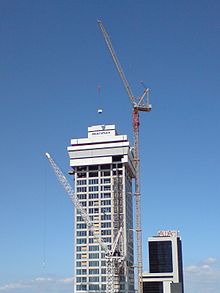Climbing formwork

Climbing formwork, also known as jumpform, is a special type formwork for vertical concrete structures that rises with the building process. While relatively complicated and costly, it can be an effective solution for buildings that are either very repetitive in form (such as towers or skyscrapers) or that require a seamless wall structure (using gliding formwork, a special type of climbing formwork).
Various types of climbing formwork exist, which are either relocated from time to time, or can even move on their own (usually on hydraulic jacks, required for self-climbing and gliding formworks).
Process
[edit]Best known in the construction of towers, skyscrapers and other tall vertical structures, it allows the reuse of the same formwork over and over and over for identical (or very similar) sections / storeys further up the structure. It can also enable very large concrete structures to be constructed in one single pour (which may take days or weeks as the formwork rises with the process), thus creating seamless structures with enhanced strength and visual appearance, as well as reducing construction times and material costs (at the joints which would otherwise require extra reinforcement / connectors).[1] An advantage of guided climbing systems is that they remain connected to the building during the lifting process.
The climbing formwork structure normally does not only contain the formwork itself, but also usually provides working space / scaffolds for construction crews. It may also provide areas for machinery and screens for weather protection, up to being fully enclosed while yet staying modular around a changing building structure.[2][3]
Types
[edit]
- Climbing formwork (crane-climbing): in this type of climbing formwork, the formwork around the structure is displaced upwards with the help of one or more cranes[4] once the hardening of the concrete has proceeded far enough. This may entail lifting the whole section, or be achieved segmentally.
- Climbing formwork (self-climbing): In this type of formwork, the structure elevates itself with the help of mechanic leverage equipment (usually hydraulic). To do this, it is usually fixed to sacrificial cones or rails emplaced in the previously cast concrete.[2][4]
- Gliding formwork: This type of formwork is similar to the self-climbing type above. However, the climbing process is continuous instead of intermittent, and is usually only interrupted for a very short time (for example to fix the mounting mechanisms to new anchoring points). The advantage is that it will produce seamless structures, but it requires a continuous, uninterrupted process throughout, with serious potential quality and stability problems if the pour has to be stopped.
See also
[edit]References
[edit]- ^ "Chicago high-rise with self-climbing formwork". Concrete Construction, July 2003, via 'findarticles.com'. Accessed 2008-06-16.
- ^ a b "Building towers over Auckland's North Shore". NZ Construction News, Volume 2, Issue 3, July 2007
- ^ New „Tour Granite“ building in the Paris financial district[permanent dead link] (from a Hünnebeck press release. Accessed 2008-06-16.)
- ^ a b "Beetham Tower, Liverpool - innovation in climbing formwork Archived 2006-10-21 at the Wayback Machine" (abstract from the AZoBuild.com building and construction knowledge base website. Accessed 2008-06-16.)
External links
[edit]- The Jump Form System Archived 2012-12-18 at archive.today—manufacturer's website containing animated diagram of a self-climbing formwork
